Following is a brief D-Day account -- this article was published on
the National Geographic website for the 60th Anniversary of the Normandy
Invasion.
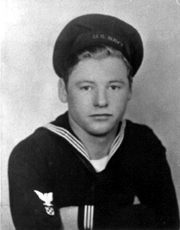
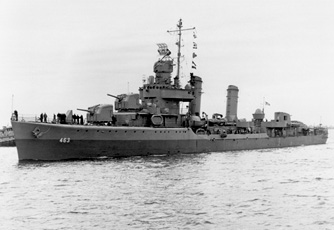
Thomas L. "Red" Groot
Boatswain's Mate, 1st class,
USS Corry (DD-463)
(email: t l g 5 7 1 9 @ s h e n t e l . n e t )
"Boats' " Red Groot, USS Corry Sailor
Reminiscence of D-Day Tuesday June 6, 1944
by Thomas L. Groot BM 1/c
The Sinking of the USS Corry DD-463 at Utah Beach
As the gun captain of No. 3 gun a 5" 38 cal. mount on the after deck house of the USS Corry, going to the assigned fire support area at 0530 Utah Beach, June 6 1944. I have a good all around view of the Normandy Invasion action at my "General Quarters" station above the gun mount. It's still real dark. The planes can be heard flying over the ship by the hundreds, on the way to bomb the troop landing areas and artillery positions on the beach. And shortly, the whole shoreline jumps into view from the planes’ bombardment. The shoreline, far as you can see in either direction is lit up with exploding bombs. The ship is steaming along very slowly toward the landing beaches – still too dark to see any assigned targets on the shore. The sound is like a continuously rolling thunder, flashes from the bombs going off, flickering through the smoke clouds from the bombs. It's awesome to watch.
As it is getting lighter the Corry is closing in on the beach. I have a visual on the land now and the bombing on the shore has slacked off and I see a few shells splash in the water a short distance ahead. Then I hear control say over the phone that we may be fired upon, that perks my ears up. Then word comes over the phones for "Action starboard" I tell the men to "Load" and to shift to automatic. There is a short wait, and I'm back out the top of my mount. There is a small stand and a hatch in the back of the gun mount for the gun captain to stand on waist high above the gun mount. Then BLAM the gun fires, I duck down in the mount to tell them to reload, and they have already reloaded. There were several more salvos fired from the ship to some target on shore that was firing at us. Word comes over the head phones that we silenced it. Then I get a "Cease fire," and the gun trains in, still loaded. Hey I'm thinking, This is going to be a snap.
Corry proceeded to its assigned firing position and started firing at selected targets on shore. All hell has broke loose. Shellfire from the German shore batteries is dropping all around the ship. It's
daylight now. One shell hit amidships injuring a man’s shoulder. Another shell hit the bow. Some very large gun on shore is zeroing in on us, I can tell by the plumes of the shell splashes the Corry is now silhouetted alone against a smoke screen. The anchor is hauled in and the captain orders flank speed ahead and full left rudder. Our guns are still in rapid fire; the shore batteries have found their target though. As the ship lunges ahead a salvo from the big guns hits amidships in the engineering rooms severing the keel and practically cutting the ship in half. With the rudder jammed the ship made a circle before it ran out of steam and commenced to sink. "Abandon ship" was given. Hours in the cold Channel water and the continued shelling at the USS Corry and the men in the water from the German shore batteries after the ship settled on the shallow bottom added to the fatalities and casualties. There were 24 KIA and an unknown number of wounded.Survivor, USS Corry (DD-463)
Thomas L. Groot- BM1/c
© 2002 T. L. Groot
USS
Corry Sailor Remembers D-Day
Normandy Invasion and Fatal Shelling of USS Corry
Utah Beach, France
U.S.S. CORRY DD 463
Bristol 1700 CLASS
"Boats' " Red Groot BM1
Tuesday June 6, D Day 1944- 0633 -
the sinking of our great ship in the Normandy Invasion.
The Normandy Invasion actually
started on June 5th 1944 but the worst storm in 50 years hit the English
Channel early that morning. General Eisenhower, Supreme Commander of Europe,
ordered a twenty-four hour delay in the invasion of Normandy and the whole
Fleet of the invasion force was recalled back to England. The Corry was
designated to proceed on toward France to turn back those ships that did not
get the word of the postponement.
The next morning very early, more like midnight, the Corry was under
way again and we knew this would be “IT”. There was a lot a maneuvering
and waiting crossing the channel and then very carefully entering the narrow
mine swept channels guiding the Invasion Forces leading to Utah beach. The
ship is at “G.Q.” In the darkness you could hear the planes by the
hundreds flying over us. Shortly, the whole shoreline jumped into view from
the exploding bombs dropped by the planes that continue, over us. The
flashing from so many bombs, like chain lightning at night in the clouds of
a great thunderstorm, lighting up the shoreline for miles with brilliant
red-orange and white flashings, silhouetting the clouds of smoke with the
flashing bombs, making an unforgettable and horrible sight. The thundering
sound from it was shaking your clothing and you could even feel the sound
waves on your face over the wind. This is my view from atop the gun mount as
the ship was approaching its designated firing position off Utah Beach as
Gun Captain of the number 3, 5-inch gun mount on the after deckhouse of the
USS Corry DD 463.
The Gun Captain’s General
Quarters station is a small stand in the rear of the gun mount with a hatch
opening in the top of the mount that allows the Gun Captain to stand waist
high over the top of the mount. From this position the Gun Captain has
control of firing the gun, locally, or by automatic settings from the main
Director that directs the fire control of the 5"-38 Gun and directs his
gun crew in the mount, handling room and magazine.
The Corry was closing in on
the beach. An island suddenly loomed in sight off to starboard (St. Marcouf
Island). It is after 0530 and getting light enough to see the shoreline when
the word was passed over my headphones to “Load, shift to automatic and
stand by”. The crew reacted to load the Gun quickly, the word soon
followed to “Commence firing”. Then it was on. Like all hell was
breaking loose.
My
5-inch gun crew is experienced and very good at what they do. My 5-inch-gun
mount is firing in automatic, very rapid, controlled by C.I.C. Still
standing on my little platform head and shoulders above the mount watching
the shore. It is about 0540, and still a mass of exploding shells and bombs
are dropping on the shore from the planes’ and ships’ bombardment,
unbelievable, the whole shoreline is a solid line of fire, as far as you can
see of it in either direction. The mass of shelling from other ships and
with the Corry’s adding to it I cannot tell which ones are ours; ours was
directed at predetermined inland targets. The battleship U.S.S. Nevada and
several cruisers, one being the U.S.S. Quincy, are out of sight to seaward
of us. The U.S.S. Nevada’s shells can be heard, a rapid swish-swish-swish
going over my head. I can hear each salvo from atop the gun mount and
mushrooming on shore adding to the booming thunder. The skies over the
beaches are a mass of layered smoke clouds highlighted by the simultaneous
bomb flashings, with some further flashes inland lighting up the back layers
of clouds. There are German antiaircraft shells bursting over us, targeting
the bombing planes coming in over them in the early dawn. I see one plane
get hit and go down leaving a trail of smoke. Orders come over the headphone
“check fire”. Our gun-mount has fired about ninety rounds of ammo thus
far. The gun crew has rotated in their loading positions; one 5-inch shell
weighs 54 pounds with separate powder casings weighing somewhat less. Over
the shore I see another plane get hit and go down in flames. The ship has
swung starboard side to the shore, tending with the tide with the ship at
anchor it is back into firing position and commences rapid fire again.
Scuttlebutt on the headphones tells me that we have dropped the anchor to
short stay at 1000 yards from shore. I hear over the headphones, “knock
off the noise”. I believe that was the last chatter that came over them
for some time. My Gun-Mount is firing rapidly, about three rounds per
minute; as the ship’s Main Director is controlling its aiming and firing.
Many
various size shell plumes hitting the water close by can be seen mixed with
the whitecaps on the water caused by a brisk wind. A shell hit the water off
the starboard quarter, maybe 75 yards, raising a large plume of water,
followed by another one close to the starboard bow. Looking back to seaward
a B-24 plane is laying a big smoke screen and silhouetting the Corry against
it. Turning back toward the shore there is another plane laying one between
the Corry and the beach. I am looking right at it when a German antiaircraft
shell had a direct hit on it. The plane blew up in a huge ball of fire and
smoke cloud with a lot of fireworks going off in the smoke cloud. Nothing
was left of the plane but a few small pieces that splashed down into the
water that were hard to distinguish among the little white caps. I watched
to see if the Pilot emerged out of it, I really didn't expect to see a chute
open up though with such a huge explosion, bellowing white clouds and the
fireworks going off in the center of it, 50 yards off the starboard quarter.
That really left the Corry a sitting duck against the smoke screen to
seaward of us for the shore batteries to target us. The bow of the ship and
the Bridge both took a direct hit. Shellfire raked the ship. Shell plumes,
large and small are hitting the water all around us, with the choppy water
kicking up little white caps. The large white smoke cloud drifting off where
the plane had blown up, I'm thinking in the back of my mind that this is a
beautiful sight to see.
One of the larger German shore batteries is zeroing in on us. I see a huge shell plume hit the water just astern of us, the largest shell plume I have seen so far, taller than the mainmast of the ship, It caused me to duck my head down in the mount, but I was right back up in time to see another shell plume hit close to the bow, the same size large plume that hit astern of the ship just seconds earlier. Whoa! I was thinking they just straddled us and to get down in the mount. At the same time the ship shuddered and seeing the foam from the screws kick up I knew that full speed ahead had been rung up, and the anchor must be in sight.
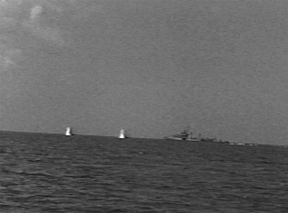
Two near misses off
USS Corry bow on D-Day
Ducking down into the mount
and shouting to my gun crew that we had been straddled by some big shellfire
and to stand by for a hit. The top Gun Mount hatch was about closed and I
was removing my left hand from the hatch combing when at the same time it
hit. My helmet and headphones went flying and I was trying to hang onto the
hatch handle. This action shook me loose from the hatch I was holding onto
and threw me across the inside of the mount landing on top of the hot
shellman. All power is lost; the ship seemed to turn upside down. Seawater
came squirting in from all the openings around the inside of the mount. It
poured up from the ‘hot shell’ opening in the bottom of the mount in a
large clear column of water brightly lit up with sunlight that allowed me to
see plainly all around in the closed gun mount. I was then thrown back
across the top of the inside of the mount. A column of water is now pouring
in, flowing toward the top of the mount practically filling the mount with
water. I have a flash moment that I'm suspended in air or floating in water
inside the mount and didn't know down from up. A bad thought hit me that the
mount had been blown off the ship and we were sinking in it. The ship
finally did turn upright and the water drained out of the mount down the
shell hoist and powder case opening into the handling room soaking
everything in it. Later, finding out that there were three 210 mm (8.25 inch)
shells hit and blew up in the engineering space; with the force of the
explosion it healed the ship over on its starboard side and slew her on her
side some fifty feet, keel first. Submerging the gun mount completely under
water, dredging up water into the ‘hot shell’ opening as the ship slid
on its side. The gun-mount had swung around radically from the starboard
side that we were firing from, and hit the stops on the port side of the
ship ending up facing back to the ship’s port quarter. That accounted for
the disorientation and being thrown about in the mount. We were all shaken
up from that action of the mount swinging around, it also put the gun out of
commission. However, we all managed to get out of the mount in fairly good
condition. Thanks to my hot-shellman breaking my fall I ended up with only a
small knot on my head and my right arm wrenched from trying to hang on to
the hatch cover. Looking back into the mount there is a 5-inch shell laying
in water down in the elevation well and a 5-inch powder casing, with the
safety cap off, crushed, laying next to the shell with the wet gun powder
spilled all over the deck of the mount. Luckily, the powder was wet. My
trainer tells me the gun cannot be trained in either direction and the
pointer says his control doesn't operate even in manual position. I cannot
help noticing the barrel of my 5-inch gun; it was depressed almost touching
the deck; which is not normally possible. The heavy breach end of the gun at
one time during the explosion was down into the elevation pit, a fully
elevated position, mashing the powder casing, splitting it open and spilling
the powder over the inside of the mount. The liner in the barrel from the
heat and friction from firing it was extended four to five inches out of the
barrel. The outside of the barrel had the paint all burnt off of it from the
heat. We had fired about 130 rounds (my count) during the last shore
bombardment.
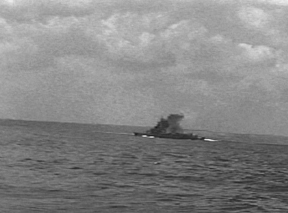
USS Corry hit amidships
The ship was going around in a
large circle out of control from the bridge.
All electric power is lost and the ship is driven by the after
boiler’s remaining steam. Men
are scrambling around the after steering hold, trying manually to steer the
ship away from the shore to seaward. The ship made one complete circle and
ended up back in the same place where the shells had hit us. She then went
dead in the water and was beginning to buckle downward in the middle,
between the forward upper decks and the after deckhouse. The ship is
sinking. Word is being passed by mouth to abandon ship. My crew went down
off the deckhouse to check out the handling room and magazine to see if the
men in them were all out.
Several
of the men are releasing the Life raft from the port side of the after
deckhouse -- this is our abandon ship station. The ship is taking shellfire
from the shore; I can hear them zipping by me. Making my way down the port
side ladder from the deckhouse, away from the shore side, I went in to check
the handling room myself. There are several mashed and mangled open
gunpowder canisters, and powder is spilled completely over the deck; several
mashed canisters still jammed under the shell hoist. Fear wells up in me to
see it, knowing what could have happened. Going down into the opened hatch
of the Magazine, it is dark.I hollered to see if anyone is left in there.
Nothing. No one answers. Upon coming up out of the Magazine hatch, Captain
Hoffman enters the handling room with the question “What are you doing in
here?” I tell him "checking it out sir". He asked me what I
thought hit the ship to cause that much force to split it in half and sink
it? I tell him my thoughts about the very large shell splashes straddling us
and said I thought it was one of those larger guns from the shore that hit
us. The Captain said "it must have been something bigger than that.
“Probably a mine” he says. Then he tells me to abandon ship. “Aye
Sir” I say, and he was gone. (No time to stop and chitchat).
My abandon ship station
was just outside, to port of the deckhouse. The men, too many of them for
what the raft was designed to support were already in the water around the
raft. They were urging me to hurry and jump. As I jumped it was only about
two feet to the water. Once in the water, squeezing my May West (C0-2
cartridge-inflated life jacket). I came up gasping from the cold water and
reaching for the raft, before being able to see good, I grabbed a man’s
sheath knife blade as he was cutting a line holding the raft to the ship. He
hollered at me to let go, several times, to let go of the knife, he still
would not pull the knife out of my hand, till I let go of it, so he could
finish cutting the line. My left hand was cut pretty bad, judging by the
sting of the salt water. Despite the cut I managed to tie myself to the life
raft. The men on the raft tell me when I came up out of the water that a
shell came right through the deckhouse bulkhead right where I was standing
the instant after I had jumped overboard into the water.
The Corry was sinking. Water was rushing across the mid-ship deck,
from port to starboard, and it was trying to take our raft with it. Men were
shouting to swim, and we were desperately swimming to get away from the ship
fearing it would take us down with it, and at the time not knowing
how deep the water was, or if she would blow up. To no avail, the rushing
water with the incoming tide took us right across the ship and toward shore,
just what we were trying to prevent from happening. That put us right out in
plain sight in front of the Corry with the smoke screen to seaward of the
sinking destroyer and our life raft giving the shore batteries the only
target to shoot at. The life raft was overcrowded with men and the donut
life raft was just under water. We are all tied to it with lifelines. We
agreed to stop swimming, it was getting us nowhere in our struggle. By now
we were completely exhausted from swimming and towing the life raft in the
attempt to get clear of the sinking ship and stay behind her for some
protection from the shore batteries.
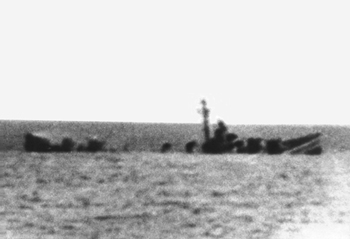
USS Corry sinking on D-Day
Shells are hitting in the water around us. Some other men in the
water are staying afloat with powder canisters under their arms. There are
white phosphorus shells bursting just above the water and toward the shore,
very close to the raft. Still other shells from shore are landing close by,
one hit so close that water completely covered the raft. I feel the
convulsion in my guts. One man across the raft from me is stretching himself
up above the raft “to see what was going on”, he said. Several of us
told him to keep his head down. Too late, He fell with his face down in the
raft water when a fragment from an exploding shell close by caught the top
of his head. We cut him loose; there was nothing that could be done for him
now, he had a life jacket on and knowing he would be picked up later. The
men are quiet now around the raft, staring, while not seeing anything.
The shelling has considerably slowed down. It’s sometime later, and the cold water is getting to us. I’m feeling a little dazed and weak. The USS Fitch, another destroyer that had been next to the USS Corry in bombarding the shore, pulled up to our raft with cargo nets thrown over the side, and commenced pulling us on board her. Being unable to move and being the last man left hanging onto the raft, and starting to fear they hadn’t seen me with just my head sticking out of the water, but two men came down and pulled me out of the water and on board. I can still hear the Captain of the USS Fitch yelling down from the bridge to “get that man on board, we have to get underway”. The men literally pulled me up the net to get me on board, I couldn't stand up so they took me to the casualty area in the Officer's Ward Room where the other men from our Corry were being taken care of. My clothes were cut off me.
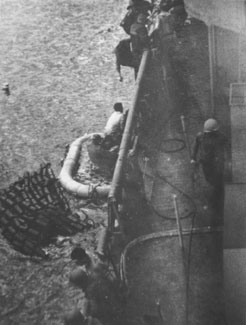
Corry survivors climbing aboard
USS Fitch (DD-462)
I had trouble keeping them from cutting through my
money belt that had $400 tucked in it. With some hot coffee and a sandwich,
feeling a little better and coming out of it, sitting there with a blanket
and a pair of khaki pants that were given me to put on. Motioning to an
officer’s steward that had just come in the Ward Room with some bottles of
(medicinal Medicine) on a tray, he came over and holding my cup up he poured
it half full. That was the best Bourbon I’d ever remembered drinking, and
thanked him for another. After, he said, “You’re welcome, sir.” He
never suspected the difference or either it made no difference to him. After
being on my feet again a Boatswain’s mate from the USS Fitch that I’d
met several times before, took me back to the crew’s quarters and gave me
some of his dungarees and I flopped onto a
bunk. After a little rest I remembered and went to the Ward Room and sorted
through the pile of clothing with some help from an Officer and found my
belt with the money in it. The Corry’s survivors that were on board the USS
Fitch were
transferred at about 1100 hours to the USS Barnett; a troop transport that
was headed back to Portsmouth England. One crewmember that was wounded in
the explosion that sank the USS Corry was too critically wounded to be moved
from the USS Fitch, the ship that rescued him from the water off Utah Beach.
From there we were all, including our Captain. Lt. Comdr. George D. Hoffman,
transported by railway to Glasgow, Scotland, for a 30-day stay in a rest
camp in Edinburgh Scotland. Then back to the U.S.A. via the Queen Elizabeth
in July 1944. Just three days crossing " the old Ditch". To New
York City and a receiving station in Manhattan, “Pier 92” It usually
took us seven days with the USS Corry to cross the Atlantic Ocean.
Given the choice of duty,
I applied for a deep-sea Diving School and it was granted. A new class was
forming in the US navy yard, Washington DC. My future wife that I met on
Pearl Harbor Day lived in Washington D.C. After
completion of diving school I was assigned duty to Piney Point, MD to the '5
Boat ' -- a sea going Tug that was rigged for diving and stationed there
recovering spent or failed-to-complete-their-run torpedoes, after being
fired on the Test Firing Range. Good duty. On September
19, 1945 I was Honorably discharged, and finished my regular Navy career as
a First Class Boatswain’s Mate and First Class Deep-sea Diver. On October
7, 1945 I married the little lady that I had met on Pearl Harbor Day, still
married today and forever. (2009) I've been there, seen that and did
that. ‘Red’ Groot, Boatswains Mate
Fair
Winds and Following seas
Thomas LaGrande
Groot
©
2006
Author
USS
Corry ‘KIA’ Plaque From Action
on D-Day June 6, 1944
USS Corry DD 463, Commissioned December 18, 1941 at
Charleston, South Carolina Navy Yard. Sunk June 6, 1944 in the Normandy
Invasion, in the Bay of Seine, France, off Utah Beach. Thirty Courageous
months of Warring on the High Seas, May God Bless Her Soul and all sailors
that survived and more especially, those who gave their lives fighting with
Her.
In Memory of Those Aboard
The U.S.S. CORRY DD463
Who gave their lives on
June 6, 1944
~~~~~~~~~~~~~~~~~~~~~~~~~
Fair winds and following Seas
CHARLES N. BAKER NICK P. MITCHELL
ORILIEN F. BEAUDRY, JR. JOHN T. NEWMYER
NORMAN R. BENSMAN GERALD E. PAHL
JAMES A. BORDERIEUX BERNARD J. PERTERSEN
WILLIAM H. BRAUNWARTH JOSEPH RADZINSKI
AUVERGNE S. BREAULT FELIX P. ROVINSKI
CHARLES E. BREWER LEWIS W. SESSIONS
JOHN CHOMBOR PAUL E. STAMBAUGH
STEPHEN V. FIGURA, JR. ROBERT V. THOMPSON
DANA E. FOGG FRANK G. TOMCHO
JAMES A. GEARHART BERNARD WADE
RICHARD E. McCLYMENT JOSEPH V. ZEMOLA
May Saint Elmo, The Sailor’s Patron Saint, be with them.
From All of The Shipmates of The USS CORRY DD463